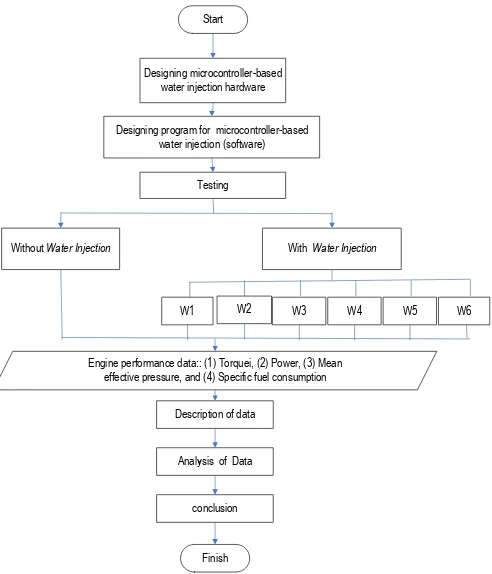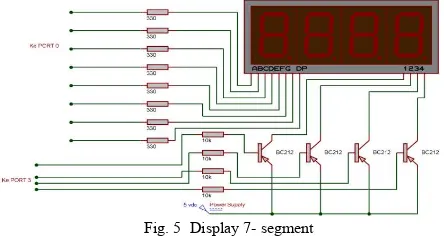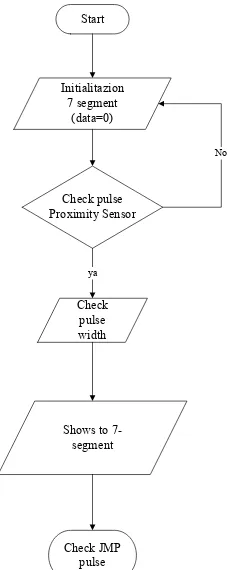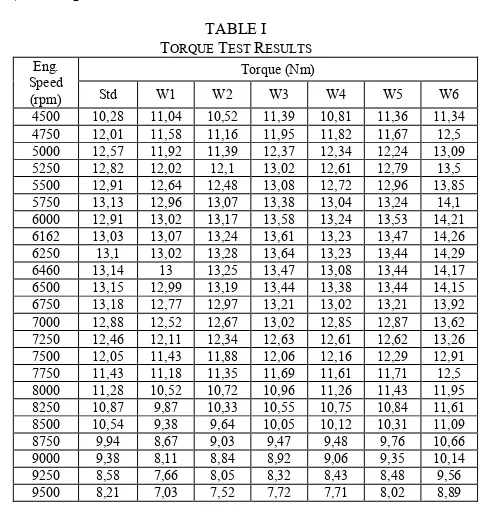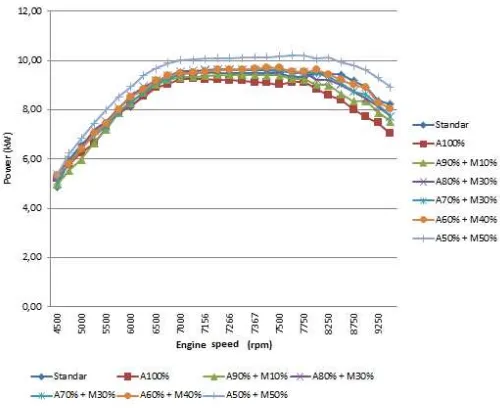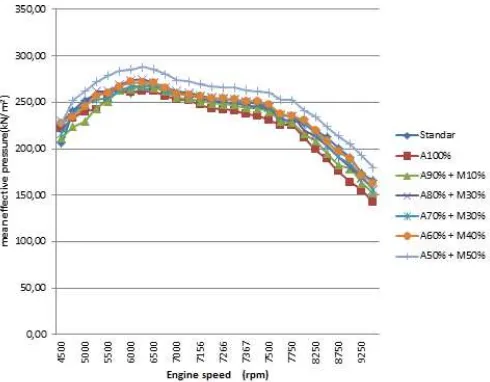Designing Microcontroller-Based Water Injection in
The Motorcycle to Improve Engine Performance
Basori
**
Department of Mechanical Engineering Education Sebelas Maret University , Surakarta, Central Java, Indonesia
Abstract — This research aims to develop technology that is
used to improve engine performance and to reduce detonation by using a water injection system. The use of water as additional fuel, have been around since the internal combustion engine found. It's just the old water injection system where is manually driven, so that the proportion of fuel mixture is not right. Its development is providing microcontroller-based electrical automation systems. With this new system, the engine performance of a motorcycle to be better.
The research used experiment method. The experiments were done on a motorcycle using a microcontroller-based water injection (WaI). The microcontroller is used to automatically adjust the water injection to inject distilled water (aquades) and methanol into the fuel chamber. Microcontroller-based WaI system is mounted on the motorcycle with the fluid composition: (1) Distilled water/Aquades: 100% (A100%), (2) Distilled water 90%, methanol 10% (A90% + M10%), (3) Distilled water 80%, methanol 20% (A80% + M20%), (4) Distilled water 70%, methanol 30% (A70% + M30%), (5) Distilled water 60%, methanol 40% (A60 %+ M40%), (6) Distilled water 50%, methanol 50% (A50% + M50%). Testing is done by measuring engine performance parameters includes the torque, power, mean effective pressure, and specific fuel consumption.
Based on the experimental result, we got the conclusion: (1) there is a positive effect of microcontroller-based WaI at the engine performance on the torque, power, mean effective pressure, and specific fuel consumption. This result compared with the motorcycle without microcontroller-based WaI. (2) The highest torque achieved with microcontroller-based water injection (Aquades 50% + methanol 50%) is 14,29 Nm at 6250 rpm and the lowest torque with microcontroller-based water injection (A100%) is 13,07 Nm at 6162 rpm. (3) The highest power achieved with microcontroller-based water injection (M50% +A50% ) is 10,22 kW at 7724 rpm and the lowest power generated with microcontroller-based water injection (A100%) is 9,27 kW at 7049 rpm.(4) The highest mean effective pressure with microcontroller-based water injection (M50% +A50%) is 288,32 kN/m2 at 6250 rpm and the lowest mean effective pressure with microcontroller-based water injection (A100%) is 261,84 kN/m2 at 5750 rpm, 6250 rpm and 6500 rpm. (5) The lowest Specific fuel consumption used
microcontroller-based water injection (M50%+A50%) are at 5500 rpm, 6500 rpm and 7500 rpm with 0,0734 Kg/kWh.
Key words -microcontroller, water injection, engine performance
I. INTRODUCTION
Indonesia as a developing country with rapid economic and population growth. At Indonesia most of people used motorcycles for transportation, thus the demand of motorcycles is very high. The Indonesia Central Bureau Statistics shows the data which explain in 2012 the users of motorcycle in this country about 76.4 billion units. The increases nearly 6 times compare with the value in the 1999. There are just 13 billion units. The communities choose motorcycles as a tool of transportation every day because it is cheaper, faster and flexible. So the motorcycle more numerous and easily found. The majority of Indonesia's population from the middle to the bottom level also choose motorcycles as personal transportation. These are the reason why the research on the motorcycle is very important at Indonesia
Today, the industry of motorcycles manufacturers at Indonesia are competing on the innovation improvement. Motorcycle manufacturers embed innovation is not inferior to the car. A lot of innovation to provide a sense of comfort, safety, engine efficiency, environmentally friendly and economical. However, an attempt to provide a useful innovation for motorcycle riders must be in harmony with the environment and the air is getting longer deteriorating.
To create technological innovations on the motorcycle with the engine that has a small dimension but greater performance, fuel-efficiency and environmentally friendly, the innovations have to accommodate the perfect combustion. The requirement of perfect combustion are the pressure of compression, a mixture of fuel and air, and an ideal temperature. The perfect combustion in the internal combustion engine is very important because give an affect on the performance and efficiency. The results of the combustion process generates in the form of heat energy where is transmitted to the connecting rod and then the crankshaft will be converted into a rotary motion.
engine is high and the engine overheat. If the heat is too high a the knocking or detonation will occur and damages the component of the engine.
Meanwhile, the definition of detonation is the event occurred more than a smouldering fire sources at the same time in the combustion chamber, and its cause sonic waves in the combustion chamber, the waves are what caused the piston sounds a "ting" (knocking), this is can damage the piston and valve wear out quickly due to excessive heat generated that could cause loss of which is reduced engine performance, increased fuel consumption and increased exhaust emissions. Detonation may occur due to use of low octane fuel in a high compression engine and the ignition timing is too advanced.
An alternative technology to improve engine performance and reduce detonation is by using a water injection system. piston, so that the induction of water necessary to increase the anti-knock fuel. This technology is already applied in turbojet engines. According Walkowski (2010), in a mixture of water into the air before the burner gives a great effect on turbojet engine thrust.
Water injection (WaI) is a water injection system in the form of droplets come into the combustion chamber. Water droplets into the combustion chamber through the intake manifold simultaneously mixed with the fuel and air. The water that is injected into the fuel chamber makes the temperature in the combustion chamber to be down. So that the thermal efficiency of the engine becomes stable. Injection of water in the fuel chamber into a compression make up and also can increase fuel octane. Ganesan argues that, "the addition of water in the fuel tank can slow the rate of combustion and reduce the temperature of the combustion gases in the cylinder which can suppress the occurrence of detonation" [1].
Based on the above description of the background, then there are research opportunities to develop a system where the water injection system is only driven manually, so that the
This study uses experimental research. This experiment was done using a microcontroller to automatically adjust water injection. Microcontroller gets the input signal from the proximity sensor to inject distilled water and methanol come into the combustion chamber. Therefore, this experiment began with the first step, is designing WaI hardware which consists of: (1) designing microcontroller-based WaI system using a proximity sensor signals, (2) designing a voltage regulator circuit, (3) designing AT89S51
microcontroller circuit, (4) designing 7-segment display, and (5) designing injector circuit. In the second stage is designing a program (software) for this WaI. And the last stage, carry out testing of this tool.
The place of the research performed in the Laboratory of Mechanical Engineering education, Faculty of Teacher Education, UNS Surakarta, Indonesia, and mototech Yogyakarta. The object of research is using Honda Mega Pro 2009.
The flowchart of research design can be seen below.
Start
Without Water Injection With Water Injection
W1 W2 W3 W4 W5 W6
Engine performance data:: (1) Torquei, (2) Power, (3) Mean effective pressure, and (4) Specific fuel consumption
Description of data
Analysis of Data
conclusion
Finish
Fig. 1 Flowchart of research design
The testing of engine performance is done by giving the treatment of Honda mega pro 2009. Microcontroller-based WaI system is mounted on the motorcycle with the fluid composition:
a. W1= Distilled water /Aquades: 100% (A100%)
b. W2= Distilled water: 90%, methanol: 10% (A90% +
Furthermore, the standard conditions of a motorcycle setting without applied the WaI system.
transmission gear position in the neutral condition with an engine rotation speed of 1400 ± 100 rpm , put the transmission gear in position 4 (top gear), then measuring: (1) torque and power using a Dynojet, (2) measuring the fuel consumption with a fuel meter, and testing was conducted at 4500-9000 rpm. To minimize the influence of other factors, testing is done by the following steps: All components in the motorcycle be returned in accordance with the standard vehicle manufacturer's recommendation. At the time of testing, the motorcycle was positioned in a state:
a. The fuel control system (e.g., choke, accelerator) does
not work.
b. Equipment or vehicle accessories are not operated,
except headlights.
c. Setting slit valve according to standard plant (0.1 ± 0.2
mm).
d. Fuel used is premium
e. Intake manifold modification.
f. Oil SAE 10W-40 engine new.
III.RESULTSANDDISCUSSIONS
A. Designing Microcontroller-Based WaI Hardware
1) Block Diagram Circuit
The block diagram is a basic overview of a the systems that has been designed. Each block diagram has special function. The block diagram of the system is designed, as follows:
Fig. 2 Block diagram of the circuit
The system design consists of: (1) Inductive type proximity sensors has a function to detect metal objects. Application sensors are used to determine intake valve is open. (2) Microcontroller AT89S51 has function to process digital signal from the proximity sensor. The form of processing results in digital data that is displayed in the 7 segment. The 7
segment shows the value of pulse width. (3) The Injector
has function to inject distilled water and methanol that are controlled by microcontroller AT89S51 with frequency scale (Hz) and duty cycle (%) after getting the data from the proximity sensor.
2) Design of Voltage Regulator Circuit
This circuit consists of IC 7805, fuse, 100uF and 1000uF electrolytic capacitors. The function of this circuit is decreasing the battery voltage from 12VDC to 5VDC, according to the needs of the microcontroller. IC 7805 is used to decrease and stabilize the voltage from 12VDC to 5VDC with a current of 1 ampere. Before 12V DC voltage enter into an IC 7805, there is a 100uF electrolytic capacitors to filter 12V DC voltage ripple.
Fig. 3 Voltage regulator
3) Designing AT89S51 Microcontroller circuit
The microcontroller circuit as a central controller and data processor of the all system. The main components in this circuit is IC AT89S51 microcontroller. In this circuit , there is a 12 MHz crystal oscillator component. This component is used to generate the internal pulse and two 33pF capacitors which serves to stabilize the frequency.
Fig. 4 Circuit of microcontroller AT89S51
4) Designing 7- Segment Display circuit
This circuit is uses four-digit 7 segment that is used for display digital pulse width. The 7- segment type that is used in this circuit is the common anode. The anode is connected to one (common) with Vcc 5 VDC. There are four transistor PNP (Positive-Negative-Positive) as switching the data to the microcontroller.
Fig. 5 Display 7- segment
5) Designing The circuit of the injector
burdened. In addition to a current amplifier, NPN transistor flows the voltage to the injectors. LED is only used as a marker of the pulse signal out.
Fig. 6 Injector circuit
B. Designing Software
1) Flowchart
Software design begins with a flow diagam or flowchart. According to Mulyanto [2], Flowchart or flow chart is a schematic/chart (chart) that is showing the flow in a program logic (2008: 103). The flow chart is designed, as follows:
Start
Initialitazion 7 segment
(data=0)
Check pulse Proximity Sensor
Check pulse width
Shows to 7-segment
Check JMP pulse
ya
No
Fig. 7 Flowchart water injection programming
The first instruction is 7 segment initialization. Initialization aims to establish a 7 segment display to display the output rotation (rpm). Unit data on 7 segment filled empty, so before the program runs 7 segment in dead condition. After 7 segment initialization, the program runs a check pulser. If the signal from the pulser contains 1bits, it will be processed by the program to be shown on the display in the form of
pulse width which has been calculated by the program. If the pulser signal does not produce a binary 1, then it will go back to 7 segment initialization. Next, the data processing of the pulse width will be used as the injector output. The program will be back to check pulse if the process has been completed.
2) Water Injection Programming
There is a program that is using assembler programming-based to control the injector. This program can be seen:
$ Mod51
org 00h; address 00h
pulsa0 bit P1.0; bit P1.0 is an input pulse proximity sensor inject bits P1.3; bit P1.3 is output injector
siginj bit P1.2; bit P1.2 is output indicators injector ; --- --- ; The main program routine t-on = 0.12 ms
; --- --- start: setb inject; active low
clr siginj
active: jb pulsa0, exit0; jump jump if bit set these bits (pulses 0) containing 1
off: setb inject clr siginj
mov r3, # 2; Data 2 is filled to r1 back1: mov r4, # 15; Data 15 filled to r2 back2: DJNZ r4, back2
DJNZ r3, back1 jnb pulsa0, off jmp exit
exit0: call inj; running routine injector exit: jmp active; returned check pulse
; --- --- ; Routinely inject t-off = 1.6 mS
; --- --- Inj: clr inject
setb siginj
mov r1, # 2; Data 2 is filled to r1
lagi1: mov r2, # 200; Data 200 filled to r2 lagi2: DJNZ r2, lagi2
DJNZ r1, lagi1 ret
end
(1) Reservoir, (2) Diaphragm pump, (3) Pressure gauge, (4)Pressure regulator, (5) Injector, (6) Microcontroller , (7) Proximity sensor (8) Battery, (9) Switch, (10) Resistor
Fig. 8 Overall circuit of microcontroller based WaI System
Fig. 9 Microcontroller based WaI system which has been made
The working principle of microcontroller-based WaI are as follows: when the engine is turned on, the switch (9) is positioned on. Electric current flows from the battery (8) to a diaphragm pump (2). Furthermore, the pump will work to push the water or water and methanol with a stable pressure. Adjusting the pressure that occurs during the pumping process, a pressure gauge is equipped (3). Working pressure is set at a pressure of 50 psi (pressure is adjusted to the pressure specifications of the injector is used). When the pumping pressure reaches the allowable pressure, the pressure is stabilized manually by turning the tuner in a pressure regulator (4). With steady pressure, water and methanol or water is sprayed into the intake manifold, through the injector (5). Water or water and methanol goes into the combustion chamber together a mixture of fuel and air.
The frequency of spraying water or water and methanol adjusted to the opening of the suction valve. For identification of the opening of the suction valve, proximity sensor (7) is equipped which will give a signal to the microcontroller (6). Microcontroller (6) will be given sensor signal processing to give the output voltage goes into the electrical system of the injector (5).
C. Engine Performance Testing 1) Torque
TABLE I TORQUE TEST RESULTS Eng.
Speed (rpm)
Torque (Nm)
Std W1 W2 W3 W4 W5 W6
4500 10,28 11,04 10,52 11,39 10,81 11,36 11,34
4750 12,01 11,58 11,16 11,95 11,82 11,67 12,5
5000 12,57 11,92 11,39 12,37 12,34 12,24 13,09
5250 12,82 12,02 12,1 13,02 12,61 12,79 13,5
5500 12,91 12,64 12,48 13,08 12,72 12,96 13,85
5750 13,13 12,96 13,07 13,38 13,04 13,24 14,1
6000 12,91 13,02 13,17 13,58 13,24 13,53 14,21 6162 13,03 13,07 13,24 13,61 13,23 13,47 14,26
6250 13,1 13,02 13,28 13,64 13,23 13,44 14,29
6460 13,14 13 13,25 13,47 13,08 13,44 14,17
6500 13,15 12,99 13,19 13,44 13,38 13,44 14,15 6750 13,18 12,77 12,97 13,21 13,02 13,21 13,92 7000 12,88 12,52 12,67 13,02 12,85 12,87 13,62 7250 12,46 12,11 12,34 12,63 12,61 12,62 13,26 7500 12,05 11,43 11,88 12,06 12,16 12,29 12,91
7750 11,43 11,18 11,35 11,69 11,61 11,71 12,5
8000 11,28 10,52 10,72 10,96 11,26 11,43 11,95
8250 10,87 9,87 10,33 10,55 10,75 10,84 11,61
8500 10,54 9,38 9,64 10,05 10,12 10,31 11,09
8750 9,94 8,67 9,03 9,47 9,48 9,76 10,66
9000 9,38 8,11 8,84 8,92 9,06 9,35 10,14
9250 8,58 7,66 8,05 8,32 8,43 8,48 9,56
9500 8,21 7,03 7,52 7,72 7,71 8,02 8,89
Based on the table 1, the optimal torque generated by motorcycle with standard conditions of 13.18 Nm at 6750 rpm. The resulting optimal torque changes when using microcontroller-based WaI (A100%), the torque generated at 13.07 at 6162 rpm, microcontroller-based WaI (M10% +A90%) produces a torque of 13.28 Nm at 6250 rpm, microcontroller-based WaI (A80% + M20%) produces a torque of 13.64 Nm at 6250 rpm, microcontroller-based WaI (M30% +A70%) produces a torque of 13.38 Nm at 6500 rpm, microcontroller-based WaI (M40% +A60%) produces a torque of 13.53 Nm at 6000 rpm, and microcontroller-based WaI (M50%+A50%) produces a torque of 14.29 Nm at 6250 rpm.
Fig. 10 Relationship between torque and engine speed
Torque tends to increase in the engine rotation speed range of 4500 rpm to 6500 rpm. This is due to the higher engine rotation speed, the volumetric efficiency is increasing well. This resulted in an increase in the volumetric efficiency of the fuel is compressed more, so that the explosion that occurred at the time of burning is greater. This great explosion generated by perfect combustion resulting in a large thrust on the piston head. The driving force which causes torque to be increased. In this situation the mixture of air and fuel mixture approaching stoichiometries.
In the range of 6750 rpm to 9500 rpm, the torque graph tends to decrease. This is due to the higher engine rotation so that the friction on the walls of the larger cylinder, the combustion process becomes incomplete and the piston does not have enough time to suck air and fuel mixture in full. A mixture that goes into the combustion chamber began to decrease so that the thrust is reduced to the piston head. From the study, an increase in the optimum torque is obtained motorcycles that use water injection (M50% +A50%) due to the mix effect antiknocking. This makes the combustion more efficient and perfect. motorcycle with standard conditions of 9,53 kW at 7156 rpm. The resulting optimal power changes when using microcontroller-based WaI (A100%), the torque generated at 9,27 kW at 7049 rpm, microcontroller-based WaI (M10% +A90%) produces a torque of 9,43 kW at 7293 rpm, microcontroller-based WaI (A80% + M20%) produces a torque of 9,65 kW at 7266 rpm, microcontroller-based WaI
(M30% +A70%) produces a torque of 9,65 kW at 7367 rpm, microcontroller-based WaI (M40% +A60%) produces a torque of 9,72 kW at 7411 rpm, and microcontroller-based WaI (M50%+A50%) produces a torque of 10,22 kW at 7724 rpm.
Fig. 11 Relationship between power and engine speed
The engine power tends to increase until the engine reaches optimum power at range 4500 rpm to 7750 rpm. This occurs because the torque increased, then volumetric efficiency is also increased. A mixture of air and fuel that goes into the combustion chamber approached stochiometric mixture so that combustion is complete and resulted in effective power produced by the engine increases.
At engine rotation speed 7500 rpm to 9000 rpm, graphic engine power decreased. This is because at high rotation torque decreased and the piston does not have enough time to suck air and fuel mixture, so that the volume of fuel that is inhaled diminishing returns and decreasing the compression pressure. It causes the combustion process to be imperfect. As a result, the effective power generated also decreased. From the results of the study indicated that the use of microcontroler-based WaI can increase the engine power.
7000 259,88 253,01 254,97 261,84 258,90 258,90 273,61
7049 257,91 252,03 253,99 259,88 257,91 257,91 272,62
7156 254,97 247,13 251,05 256,93 255,95 255,95 269,68
7250 251,05 243,20 249,09 254,97 253,99 253,99 266,74
7266 250,07 242,22 248,11 253,99 253,01 253,99 265,76
7293 249,09 241,24 247,13 253,01 253,01 253,01 265,76
7367 247,13 237,32 244,19 250,07 251,05 251,05 262,82
7411 245,17 235,36 243,20 248,11 249,09 251,05 261,84
7500 242,22 230,46 240,26 244,19 245,17 247,13 259,88
7724 231,44 225,55 229,48 236,34 235,36 237,32 253,01
7750 230,46 225,55 228,49 235,36 234,38 235,36 252,03
8000 227,51 211,82 215,75 220,65 227,51 230,46 241,24
8250 219,67 199,07 208,88 213,78 216,73 219,67 234,38
8500 212,80 189,27 195,15 203,00 203,98 207,90 223,59
8750 201,04 175,54 182,40 191,23 191,23 197,11 213,78
9000 190,25 163,77 178,48 179,46 183,38 189,27 204,96
9250 173,58 154,95 162,79 168,67 169,66 171,62 192,21
9500 165,73 142,20 152,00 155,93 155,93 162,79 179,46
Based on the table 3, the optimal mean effective pressure generated by motorcycle with standard conditions of 264,78
kN/m2 at 6500 rpm. The resulting optimal mean effective
pressure changes when using microcontroller-based WaI
(A100%), the torque generated at 261,84 kN/m2 at 5750 rpm,
6250 rpm, and 6500 rpm, microcontroller-based WaI (M10%
+A90%) produces a torque of 267,72 kN/m2 at 6250 rpm,
microcontroller-based WaI (A80% + M20%) produces a
torque of 274,59 kN/m2 at 6250 rpm, microcontroller-based
WaI (M30% +A70%) produces a torque of 269,68 kN/m2 at
6500 rpm, microcontroller-based WaI (M40% +A60%)
produces a torque of 271,64 kN/m2 at 6000 rpm, and
microcontroller-based WaI (M50%+A50%) produces a torque
of 288,32 kN/m2 at 6250 rpm.
Fig. 12 Relationship between mean effective pressure and engine speed
Engine speed with a range of 4500 rpm to 6500 rpm, the graphs of mean effective pressure tends increases until the optimum value. This is because with the engine speed rises, the turbulent flow that enters the combustion chamber rises. In these circumstances the air and fuel mixture approaching the stoichiometric mixture.
In the range of 7000 rpm to 9500 rpm, graphs mean effective pressure tends to decrease. This is due to the high rotation of
the piston only having a little time to suck air and fuel mixture, so that the volume of fuel that is inhaled diminishing returns and decreased the compression pressure. In addition to the high speed friction is very late ignition.
4) Specific fuel consumption
TABLE IV
SPECIFIC FUEL CONSUMPTION TEST RESULTS Eng.
Speed (rpm)
Specific Fuel Consumption (Kg / kWh)
Std W1 W2 W3 W4 W5 W6
4500 0,0979 0,0911 0,0925 0,0870 0,0884 0,0789 0,0802
5000 0,0979 0,0979 0,1020 0,0938 0,0952 0,0870 0,0816
5500 0,0857 0,0884 0,0938 0,0938 0,0829 0,0789 0,0734
6000 0,0870 0,0911 0,1020 0,0925 0,0952 0,0829 0,0789
6500 0,0884 0,0843 0,0829 0,0870 0,0816 0,0816 0,0734
7000 0,0952 0,0816 0,0911 0,0938 0,0789 0,0843 0,0789
7500 0,0843 0,0829 0,0965 0,0829 0,0938 0,0870 0,0734
8000 0,0843 0,1020 0,0993 0,0911 0,1020 0,0829 0,0748
8500 0,1020 0,1237 0,1305 0,1251 0,1142 0,1047 0,0857
9000 0,1264 0,1468 0,1618 0,1604 0,1577 0,1278 0,1088
The minimum specific fuel consumption generated by motorcycle with standard conditions of 0,0843 Kg/kWh at 7500 rpm. The resulting optimal specific fuel consumption changes when using microcontroller-based WaI (A100%), the torque generated at 0,0816 Kg/kWh at 7000 rpm, microcontroller-based WaI (M10% +A90%) produces a torque of 0,0829 Kg/kWh at 6500 rpm, microcontroller-based WaI (A80% + M20%) produces a torque of 0,0829 Kg/kWh at 7500 rpm, microcontroller-based WaI (M30% +A70%) produces a torque of 0,0789 Kg/kWh at 7000 rpm, microcontroller-based WaI (M40% +A60%) produces a torque of 0,0789 Kg/kWh at 4500 rpm and 5500 rpm, and microcontroller-based WaI (M50%+A50%) produces a torque of 0,0734 Kg/kWh at 5500 rpm, 6500 rpm, and 7500 rpm.
Fig. 13 Relationship between specific fuel consumption and engine speed
the study indicated a microcontroller-based WaI (M50%+A50%) contributes decrease fuel consumption better.
V. CONCLUSIONS
Based on the results of the experiment, it can be concluded as follows:
a. There is a positive effect of the usage of
microcontroller-based WaI on engine performance includes the torque, power, mean effective pressure, and specific fuel consumption.
b. The highest torque achieved with microcontroller-based
water injection (Aquades 50% + methanol 50%) is 14,29 Nm at 6250 rpm and the lowest torque with microcontroller-based water injection (A100%) is 13,07 Nm at 6162 rpm.
c. The highest power achieved with microcontroller-based
water injection (M50% +A50% ) is 10,22 kW at 7724 rpm and the lowest power generated with microcontroller-based water injection (A100%) is 9,27 kW at 7049 rpm.
d. The highest mean effective pressure with
microcontroller-based water injection (M50% +A50%) is 288,32 kN/m2 at 6250 rpm and the lowest mean effective pressure with microcontroller-based water injection (A100%) is 261,84 kN/m2 at 5750 rpm, 6250 rpm and 6500 rpm.
e. The lowest Specific fuel consumption used
microcontroller-based water injection (M50%+A50%) are at 5500 rpm, 6500 rpm and 7500 rpm with 0,0734 Kg/kWh.
ACKNOWLEDGMENT
Thanks to UNS that gives me the sponsorship for my research and thanks to the Chairman of Mechanical engineering education UNS that provides the permit research on Automotive Laboratory.
REFERENCES
[1] V. Ganesan, Internal Combustion Engines (2th ed.), New Delhi: McGraw-Hill, 2006.
[2] A.R. Mulyanto, Rekayasa Perangkat Lunak Jilid 1. Jakarta : Direktorat Pembinaan Sekolah Menengah Kejuruan, 2008.
[3] Alberto Boretti, “Water Injection in Directly Injected Turbocharged Spark Ignition Engines,” Applied Thermal Engineering, vol.52, pp 62-68, November 2013.
[4] Alliance Consulting International, Methanol Safe Handling Manual. Ed 1th. USA : Methanol Institute, 2008.
[5] J.B. Heywood, Internal Combustion Engines Fundamental, Singapore : McGraw Hill., 1988.
[6] Kurniawan, Sigit Pramono, “Pengaruh Water. Injection pada Performa Sepeda Motor Empat Langkah,” Unpublished
[7] P. Juntarakod, Analysis of Water Injection Into High-Temperature Mixture of Combustion Produck In A Cylinder of Spark Ignition Engine,
Bangkok: King Mongkut’s University Of Technology North Bangkok, 2008.
[8] Pulkrabek, W. Willard, Engineering Fundamentals Of The Internal Combustion Engine. New Jersey : Prentice Hall, 1997.
[9] R. Lanzafame, Water Injection Effects In A Single-Cylinder CFR Engine. SAE Technical Papers Series.1999-01-0568, 1999.
[10] Sagar Patel, Gaurav P Rathod, Tushar M Patel, "Water Injection Effects On Performance Characteristics Of A Ci Engine", IOSR Journal of Mechanical and Civil Engineering, Vol.11, no.3 , pp 66-70, May 2014 [11] Syahrul, Mikrokontroler AVR Atmega 8535. Bandung: Informatika,
2012.
